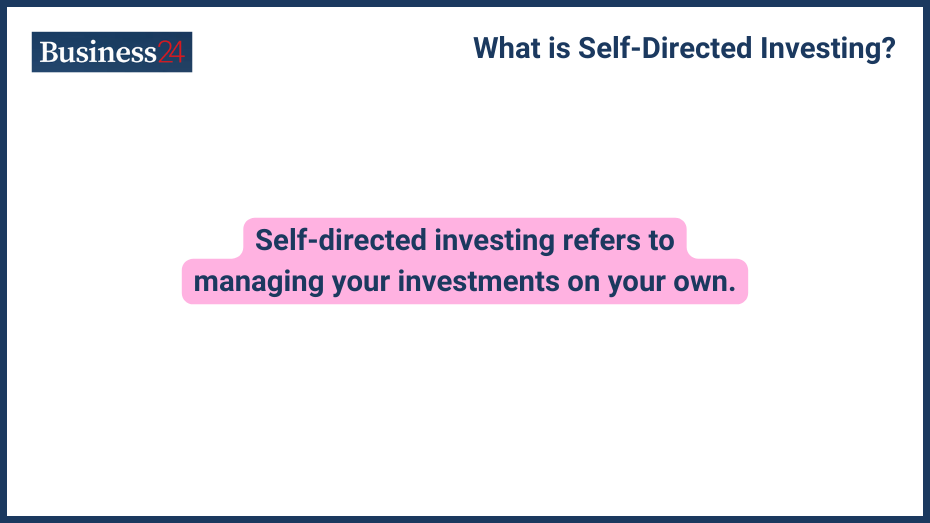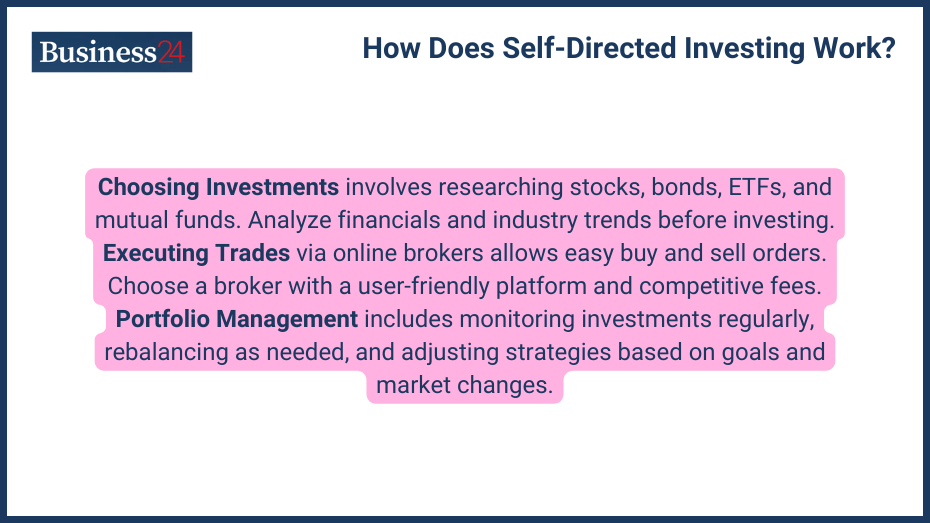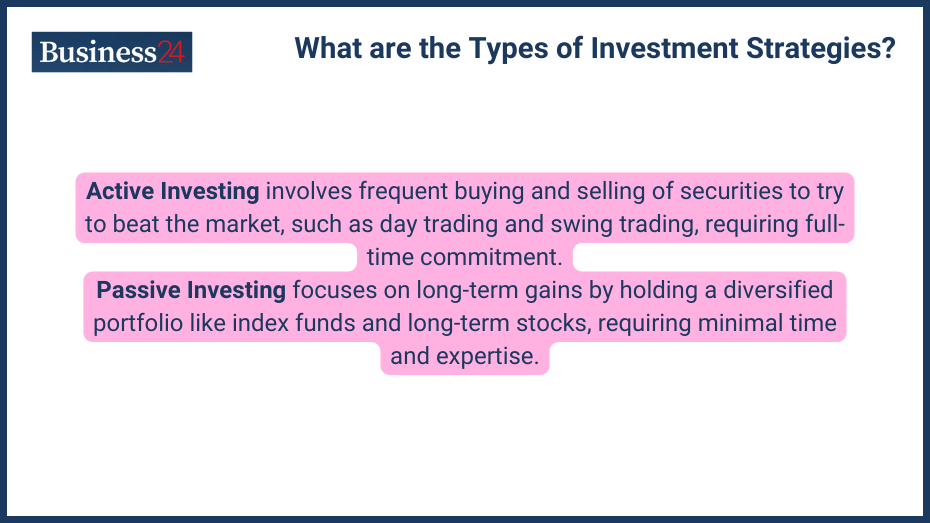
Self-directed investing refers to managing your investments on your own.
For people who don’t know how to invest and do not have the time to learn, there are various services like mutual funds, hedge funds, etc. But you can learn to invest and invest on your own without anyone’s help; this is called self-directed investing.
By definition, self-directed investing is the process in which investors make their own investment decisions and manage their own portfolios without the guidance of professional advisors.
With self-directed investment, you make decisions that align with your personal goals and risk tolerance. As you manage your own investments, you don’t have to pay any fees to professionals. Also, can make your portfolio according to your specific needs. Whether you prioritize growth, income, or a combination of both, you have the flexibility to choose investments that align with your objectives.
How Does Self-Directed Investing Work?

Self-directed investing works in the following process:
- Choosing Investments: The first step in investing is to choose the investment. You have to conduct thorough research to identify suitable investments. Stocks, bonds, exchange-traded funds (ETFs), and mutual funds are major investment instruments from which you can choose. After choosing the investment, you must analyze financial statements, industry trends, and company news to decide whether to invest or not.
- Executing Trades: Once you’ve chosen your investments, online brokerage platforms allow you to easily place buy and sell orders. Research different brokers to find one that offers a user-friendly platform, competitive fees, and the investment options you desire.
- Portfolio Management: Once you have bought an investment, you have to regularly check the fundamentals and financials around it. Monitor your portfolio’s performance, rebalance when necessary to maintain your target asset allocation, and adjust your strategy as your goals or market conditions evolve.
What are the Types of Investment Strategies?

There are two types of investment strategies:
- Active Investing: Active investing is more of a hands-on approach that involves frequent buying and selling of securities in an attempt to outperform the market and make a profit. Day trading and swing trading are examples of active strategies; you must treat active investing as a full-time job because it requires time and commitment.
- Passive Investing: This is a long-term approach that focuses on replicating market performance by holding a diversified portfolio of assets. Passive investing is a buy-and-hold type that does not require much time and expertise. For example, index funds, long-term stock holdings, etc.
What are the Benefits of Self-Directed Investing?
There are various benefits of self-directed investing:
- Control: When you manage your investment, you have control over it, allowing you to align your portfolio according to your needs.
- Cost Savings: Self-directed investing typically involves lower fees compared to managed accounts, where you pay advisor fees on top of investment expenses.
- Customization: If you are in your 20s, you can be aggressive in your investment, but if you are in your retirement, you don’t want to be that aggressive. Self-directed investment allows you to customize your investment according to your situation.
What are the Risks Associated with Self-Directed Investing?
With benefits, there are some risks associated with self-directed investing:
- Lack of Professional Guidance: It takes a lot of time to learn in investing; you learn from your mistakes. So, it may be possible that in the start you can lack proper knowledge and make some mistakes that are less probable with professional guidance.
- Time-Consuming: If you are investing by yourself, you must analyze company reports, concalls, industry trends, etc. Seld-directed investing is time-consuming so you have to give a lot of time to learning and managing it.
- Potential for Higher Losses: As I said earlier, as a beginner or without proper knowledge, you are prone to losses, and that can lead to high losses. So, before starting self-directed investing, you have to learn the art of investing.
How to Get Started with Self-Directed Investing?
Here are the steps to get started with self-directed investing:
- Educate Yourself: Before anything, you must learn to save your capital because, without any capital, you can’t do anything. That’s why learning about every aspect of risk management and how to do investing is important.
- Choose a Brokerage: You are going to gain experience in the live market only, and as a new investor, you should start small. To start investing, you have to open a brokerage account.
- Develop a Strategy: Develop a strategy that aligns with your goals, risk, and limited capital you have. Without a strategy, you are going to make many mistakes that can result in big losses.
- Start Small: Everyone wants to make money fast, and without thinking of risk, they put big capital without proper knowledge or guidance, and this can be very dangerous to your financial health as it can wipe your capital as well as your confidence.
What Tools and Resources are Available for Self-Directed Investors?
Various books, articles, and online courses can significantly enhance your investment knowledge. You can find many of these free of cost by searching the internet. Also, portfolio management software helps you track your investments’ performance and rebalance your portfolio as needed. Stock screeners and financial calculators can make your research and decision-making processes easier.
In your investment journey, you have to stay informed with access to market analysis, news, and research reports, which are provided by many brokerage platforms and financial websites.
What is the difference between self-directed and managed investing?
In self-directed investing, you’re in the driver’s seat, making your own investment decisions and managing your portfolio. It offers a higher return possibility but also requires intensive research and hard work,
A professional advisor manages your portfolio based on your goals and risk tolerance. This approach comes with higher fees but offers expert guidance and saves you time on research and management.
What is the meaning of passive investment?
Passive investing is a long-term strategy that aims to copy the performance of a particular market index by holding a diversified basket of assets. This approach requires lower fees and requires less management compared to active investing. The potential returns are also generally lower with passive investing, as you aim to match the market average rather than outperform it.
What are the Differences Between Active and Passive Investing?
Active Investing
Pros:
- Potential for Higher Returns: As the name suggests, you must be active and try to outperform the market by buying undervalued assets or capitalizing on short-term market movements. Frequent buying and selling result in higher return potential.
- Flexibility: Active investors are not bound by a specific index. They can adapt their portfolio to changing market conditions and exploit new opportunities as they arise.
Cons:
- Higher Fees: Actively managed funds typically come with higher expense ratios due to the research, analysis, and trading involved. These fees can eat into your returns.
- Increased Risk: The pursuit of higher returns often comes with increased risk. Active managers may make losing bets, and their performance is heavily reliant on their individual skills and market timing.
- Requires Time and Expertise: Successful active investing demands significant time and effort for research, analysis, and portfolio management.
Passive Investing
Pros:
- Lower Fees: Passive investments like index funds or ETFs require lower fees as there is no frequent buying and selling. You can save the fee, reinvest it, and potentially grow it over time.
- Less Time-Consuming: Passive investing requires less ongoing research and management compared to active investing. This allows you to focus on other aspects of your life while your portfolio grows in the background.
- Reduced Risk: By diversifying across a broad market index, passive investing inherently reduces risk. You’re not relying on the success of any single company or sector.
Cons:
- Typically Lower Returns: Passive investors aim to match the market’s performance, which may be lower than an active manager can achieve under ideal circumstances.
- Less Flexibility: Passive investors are limited to the holdings within their chosen index. They cannot take advantage of specific investment opportunities that arise outside the index.
Practical Applications and Case Studies
Successful Self-Directed Investors
One of the legendary examples of a self-directed investor and trader is Jesse Livermore. In the 1907 market crash, Livermore reportedly made $1 million (equivalent to about $30 million today) by shorting the market. Also, in the 1929 market crash, He made a fortune estimated at $100 million (approximately $1.5 billion today) by correctly predicting the crash and taking short positions.
Another example is Charles Darvas, often known as Nicolas Darvas, who was a dancer and self-taught investor who gained fame for his stock market success, documented in his book “How I Made $2,000,000 in the Stock Market. Reportedly, Over approximately 18 months, Darvas turned his initial investment into $2,000,000 using his unique “box theory” of trading.
Disclaimer
eToro is a multi-asset platform which offers both investing in stocks and cryptoassets, as well as trading CFDs.
Please note that CFDs are complex instruments and come with a high risk of losing money rapidly due to leverage. 51% of retail investor accounts lose money when trading CFDs with this provider. You should consider whether you understand how CFDs work, and whether you can afford to take the high risk of losing your money
This communication is intended for information and educational purposes only and should not be considered investment advice or investment recommendation. Past performance is not an indication of future results.
Copy Trading does not amount to investment advice. The value of your investments may go up or down. Your capital is at risk.
Don’t invest unless you’re prepared to lose all the money you invest. This is a high-risk investment and you should not expect to be protected if something goes wrong. Take 2 mins to learn more
eToro USA LLC does not offer CFDs and makes no representation and assumes no liability as to the accuracy or completeness of the content of this publication, which has been prepared by our partner utilizing publicly available non-entity specific information about eToro.
